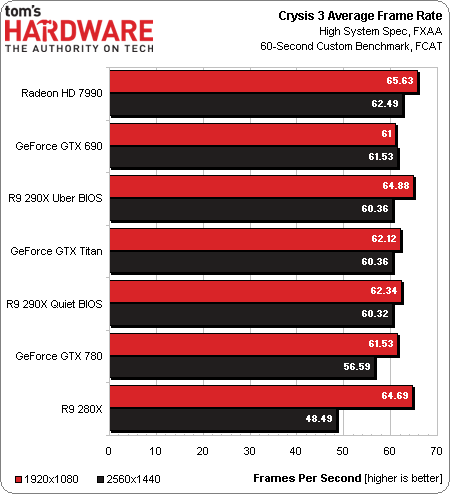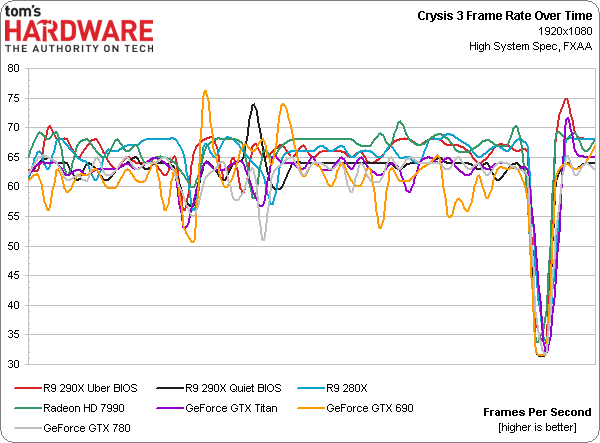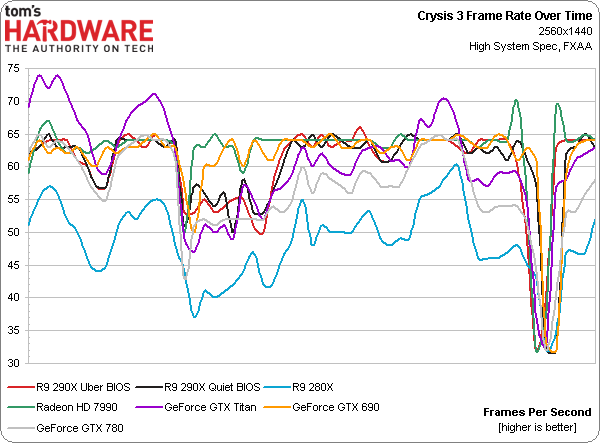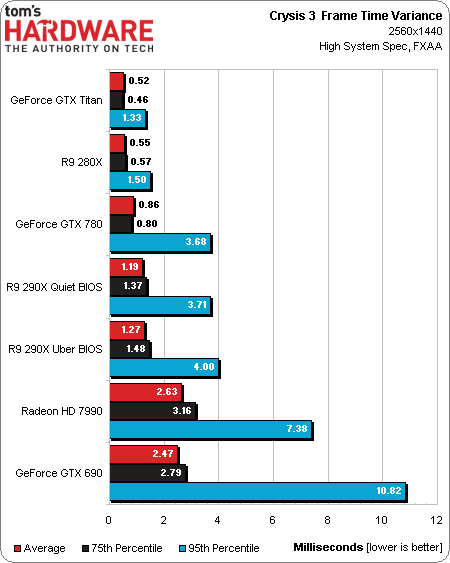Radeon R9 290X Review: AMD's Back In Ultra-High-End Gaming
After eight months of watching Nvidia go uncontested in the ultra-high-end graphics market, AMD has a new GPU based on existing technology that promises to challenge the top position. It gets mighty loud at times, but you can't ignore the R9 290X's price.
Results: Crysis 3 At 1920x1080 And 2560x1440
As with BioShock, I wanted to maintain the same test setting in Crysis 3 across our three resolutions for comparison purposes. Interestingly enough, the numbers we see from Radeon R9 280X match up with what we saw in AMD Radeon R9 280X, R9 270X, And R7 260X: Old GPUs, New Names, even using a newer driver. However, more powerful graphics hardware appears to push us into a platform bottleneck at 1920x1080 and 2560x1440. The easiest way around this would be using a more taxing detail preset (though as you’ll see in the Ultra HD tests, High is really the ceiling for single-GPU gaming at 3840x2160).
At 1920x1080, all of the cards fall into a narrow range. Pushing to 2560x1440 spread it out a bit. But it won’t be until we reach 3840x2160 that we see the bars better-differentiated.
What about all of those spikes and dips? Crysis 3 is the one game in our suite that requires manual input to run through a preset path. Enemies take different paths and terrain gets affected by explosions. We typically run this test multiple times when it looks like something might affect the outcome noticeably, but the more severe discrepancies at 1920x1080 seem to confirm that the platform is playing more of a role in the frame rates than our powerful graphics cards.
Less consistent frame delivery affects the dual-card solutions most. AMD’s Radeon HD 7990 sees the highest average variance, though Nvidia’s GeForce GTX 690 gets hit by more severe worst-case results.
Get Tom's Hardware's best news and in-depth reviews, straight to your inbox.
Current page: Results: Crysis 3 At 1920x1080 And 2560x1440
Prev Page Results: BioShock Infinite At 3840x2160 Next Page Results: Crysis 3 At 3840x2160-
beta212 That's incredible. Especially at high res, I wonder how they do it. But the low price alone is enough to blow the competition away. Seriously think about it, it's around half the price for higher performance!Reply
- AMD: We're not aiming for the ultra high end.
I think Nvidia just got trolled. -
slomo4sho Great price point. This card has already broken world records just a few hours after release!Reply
-
esrever 2 of these for 4k looks amazing but Im a little disappointed by the power consumption when you crank up performance.Reply -
aznguy0028 I was thinking about hopping on the 7970ghz when it's on sale, but after seeing this, it's time to break apart the piggy bank for the 290x, what value!Reply -
Benthon Like the conclusion said, you just can't argue about aesthetics and thermals at this price point/performance. Well done AMD, lets see team green's response! Go consumer!Reply -
Shankovich Wow, and it's pegged at 73% too. Even if nVidia's "780ti" beats the 290X, it probably won't beat a 290X running at full power. And if mantle does make some big performance boosts, nVidia is going to be in a really tight spot. Looking forward to what they'll do. In the mean time, loving this competition! We all win in the end.Reply -
anxiousinfusion Wait the 290 X... X? is going to be $550?! Forgive me, padre for I have sinned.Reply




